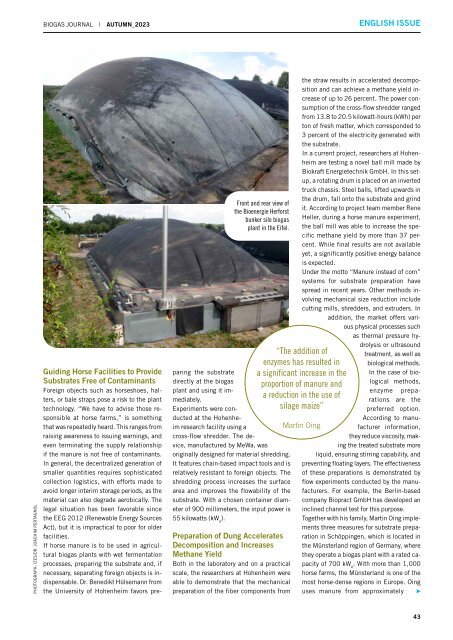Autumn 2023 EN
The German Biogas Association presents its autumn 2023 issue of the English BIOGAS journal.
The German Biogas Association presents its autumn 2023 issue of the English BIOGAS journal.
- No tags were found...
You also want an ePaper? Increase the reach of your titles
YUMPU automatically turns print PDFs into web optimized ePapers that Google loves.
BIOGAS JOURNAL | AUTUMN_<strong>2023</strong> <strong>EN</strong>GLISH ISSUE<br />
PHOTOGRAPH: IZES/DR. JOACHIM PERTAGNOL<br />
Front and rear view of<br />
the Bioenergie Herforst<br />
bunker silo biogas<br />
plant in the Eifel.<br />
Guiding Horse Facilities to Provide<br />
Substrates Free of Contaminants<br />
Foreign objects such as horseshoes, halters,<br />
or bale straps pose a risk to the plant<br />
technology. “We have to advise those responsible<br />
at horse farms,” is something<br />
that was repeatedly heard. This ranges from<br />
raising awareness to issuing warnings, and<br />
even terminating the supply relationship<br />
if the manure is not free of contaminants.<br />
In general, the decentralized generation of<br />
smaller quantities requires sophisticated<br />
collection logistics, with efforts made to<br />
avoid longer interim storage periods, as the<br />
material can also degrade aerobically. The<br />
legal situation has been favorable since<br />
the EEG 2012 (Renewable Energy Sources<br />
Act), but it is impractical to poor for older<br />
facilities.<br />
If horse manure is to be used in agricultural<br />
biogas plants with wet fermentation<br />
processes, preparing the substrate and, if<br />
necessary, separating foreign objects is indispensable.<br />
Dr. Benedikt Hülsemann from<br />
the University of Hohenheim favors preparing<br />
the substrate<br />
directly at the biogas<br />
plant and using it immediately.<br />
Experiments were conducted<br />
at the Hohenheim<br />
research facility using a<br />
cross-flow shredder. The device,<br />
manufactured by MeWa, was<br />
originally designed for material shredding.<br />
It features chain-based impact tools and is<br />
relatively resistant to foreign objects. The<br />
shredding process increases the surface<br />
area and improves the flowability of the<br />
substrate. With a chosen container diameter<br />
of 900 millimeters, the input power is<br />
55 kilowatts (kW e<br />
).<br />
Preparation of Dung Accelerates<br />
Decomposition and Increases<br />
Methane Yield<br />
Both in the laboratory and on a practical<br />
scale, the researchers at Hohenheim were<br />
able to demonstrate that the mechanical<br />
preparation of the fiber components from<br />
the straw results in accelerated decomposition<br />
and can achieve a methane yield increase<br />
of up to 26 percent. The power consumption<br />
of the cross-flow shredder ranged<br />
from 13.8 to 20.5 kilowatt-hours (kWh) per<br />
ton of fresh matter, which corresponded to<br />
3 percent of the electricity generated with<br />
the substrate.<br />
In a current project, researchers at Hohenheim<br />
are testing a novel ball mill made by<br />
Biokraft Energietechnik GmbH. In this setup,<br />
a rotating drum is placed on an inverted<br />
truck chassis. Steel balls, lifted upwards in<br />
the drum, fall onto the substrate and grind<br />
it. According to project team member Rene<br />
Heller, during a horse manure experiment,<br />
the ball mill was able to increase the specific<br />
methane yield by more than 37 percent.<br />
While final results are not available<br />
yet, a significantly positive energy balance<br />
is expected.<br />
Under the motto “Manure instead of corn”<br />
systems for substrate preparation have<br />
spread in recent years. Other methods involving<br />
mechanical size reduction include<br />
cutting mills, shredders, and extruders. In<br />
addition, the market offers various<br />
physical processes such<br />
as thermal pressure hydrolysis<br />
or ultrasound<br />
treatment, as well as<br />
biological methods.<br />
In the case of biological<br />
methods,<br />
enzyme preparations<br />
are the<br />
preferred option.<br />
According to manufacturer<br />
information,<br />
they reduce viscosity, making<br />
the treated substrate more<br />
liquid, ensuring stirring capability, and<br />
preventing floating layers. The effectiveness<br />
of these preparations is demonstrated by<br />
flow experiments conducted by the manufacturers.<br />
For example, the Berlin-based<br />
company Biopract GmbH has developed an<br />
inclined channel test for this purpose.<br />
Together with his family, Martin Oing implements<br />
three measures for substrate preparation<br />
in Schöppingen, which is located in<br />
the Münsterland region of Germany, where<br />
they operate a biogas plant with a rated capacity<br />
of 700 kW e<br />
. With more than 1,000<br />
horse farms, the Münsterland is one of the<br />
most horse-dense regions in Europe. Oing<br />
uses manure from approximately<br />
“The addition of<br />
enzymes has resulted in<br />
a significant increase in the<br />
proportion of manure and<br />
a reduction in the use of<br />
silage maize”<br />
Martin Oing<br />
43

















